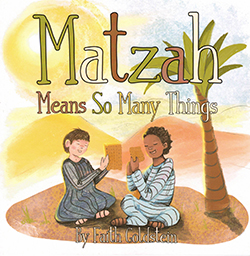Matzah Means So Many Things by Faith Goldstein; Tulsa, Oklahoma: Yorkshire Publishing © 2022; ISBN 9781954-095113; 31 pages including end notes, a recipe for making matzah at home, an author’s note enlarging for adults upon the text written for children, and a brief bibliography; $14.99 on Amazon.

 SAN DIEGO – This book, featuring interracial Jewish families as shown on the cover, switches direction about 13 pages into the story.
SAN DIEGO – This book, featuring interracial Jewish families as shown on the cover, switches direction about 13 pages into the story.
The book starts with how our senses perceive matzah. What are its ingredients? What does it look like? What color is it? What is its texture? How does it sound when it is being boiled in matzoh ball soup? How does it smell when its being baked into an apple matzah kugel? What kind of yummy foods can you spread on it?
Not only is matzah the object in the search for the afikomen, it also is eaten with charoset and maror. And it is an ingredient of other foods on the Pesach table.
On Page 13, the story of the first Passover is retold. On Page 21 we are told that with “no time to wait for their dough to rise, the Israelites left Egypt with dough in sacks strapped across their backs.”
Here comes a midrash: The desert sun baked the dough into a cracker-like bread as the Israelites carried it on their backs. So, it wasn’t pre-baked in Egypt, as one might imagine, but baked by the blazing temperatures Israelites suffered in their 40 years of wandering on the way to Canaan.
Truly, a bread of affliction.
“Matzah means so many things,” Goldstein concludes her tale for the youngsters. “Matzah is food. Matzah is Passover. Matzah is liberation. Matzah is freedom.”
In this reviewer’s opinion, that’s a stretch. But we are all entitled to invest objects with whatever symbolic qualities we fancy.
And, that’s the way the matzah crumbles.
*
Donald H. Harrison is editor emeritus of San Diego Jewish World. He may be contacted via donald.harrison@sdjewishworld.com